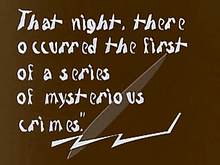In “Let’s Make More Movies,” the epistemological anarchist Paul Feyerabend wrote this:
The separation of subjects that is such a pronounced characteristic of modern philosophy is … not altogether undesirable. It is a step on the way to a more satisfactory type of myth. What is needed to proceed further is not the return to harmony and stability as too many critics of the status quo, Marxists included, seem to think, but a form of life in which the constituents of older myths — theories, books, images, emotions, sounds, institutions — enter as interacting but antagonistic elements. Brecht’s theatre was an attempt to create such a form of life. He did not entirely succeed. I suggest we try movies instead. (P. Feyerabend, “Let’s Make more Movies,” in The Owl of Minerva: Philosophers on Philosophy, Ch. J. Bontempo and S. J. Odell (eds) [New York: McGraw-Hill, 1975, pp. 201–210])
By cine-phenomenology, I mean the direct expression of philosophical ideas in cinematic, visual terms, from a first-person point of view.
Intertitles are printed texts inserted into (especially silent) films in order to convey dialogue, descriptions, or expository material directly relevant to but not necessarily covered by the filmed material, e.g.,

And montage is the cinematic technique, discovered by Sergei Eisenstein, of combining, juxtaposing, ordering, and sequencing (more generally, synthesizing) visual images for the production of various kinds of aesthetic and emotional effect.
A philosoflick is an experiment in visual philosophy, blending text and images–employing cine-phenomenology, intertitles, and montage–inspired by Feyerabend and Eisenstein, by Chris Marker’s La Jetée, and by W.G. Sebald’s pictorial novels.
Since 2015, APP has been publishing its OLD Philosoflicks series here and also its NEW Philosoflicks series on Medium–
The OLD Philosoflicks:
2, Installment 1: Frankenstein; Or, The Modern Prometheus, Preface & Letters I-IV.
2, Installment 2: Frankenstein; Or, The Modern Prometheus, Volume 1, Chapter 1.
3: On the Metaphysics of Puppets.
4: The Vienna Circle Meets The Hollow Men Meets Flitcraft Meets Us.
6: Thoughtless Images, aka Guns R Us.
The NEW Philosoflicks:
3: What Makes Life Worth Dying For?
5: Appearing, Disappearing, and Reappearing: Visual Philosophizing With Hannah Arendt, Part 1
6: Appearing, Disappearing, and Reappearing: Visual Philosophizing With Hannah Arendt, Part 2
7. Appearing, Disappearing, and Reappearing: Visual Philosophizing With Hannah Arendt, Part 3
8. The Two Greatest Living Philosophers Are Only 3.5 Inches Tall.
9. Why All The Truly Cosmopolitan Philosophers in the World Today Are Only 3.5 Inches Tall.
Now I’m also extremely pleased to be able to present the work of Hanno Depner, who has been exploring visual philosophy since 2011.
He studied Comparative Literature and Philosophy in Berlin and Norwich (UK); he has worked as editor of the International Literature Festival in Berlin and written for cultural institutions, as well as for print and online media; and he is a member of the advisory board of the DenkWelten Philosophy Museum.
Recently, he edited Visuelle Philosophie (Visual Philosophy, 2015) and Zur Gestaltung von Philosophie. Eine diagrammatische Kritik (On the Design of Philosophy: A Diagrammatic Critique, 2016).
In May 2011, Hanno was awarded first prize in the Berlin Science Slam for the presentation of his building kit Kant By Hand–for more details, see directly below.
Currently he is developing his second philosophical building kit, on Wittgenstein, and teaching at Rostock University.
He can be contacted at: <hannodepner@hotmail.com>.
Kant By Hand–Make It, Grasp It, by Hanno Depner (2011)
Kant By Hand – Make It, Grasp It, created by the philosopher-designer Hanno Depner, is an introductory book-based building kit that can be transformed into a 3D infographic on Immanuel Kant’s Critique of Pure Reason.
It was originally published in German by Knaus publishing house in 2011, under the title Kant für die Hand.
Here’s how it works:
(1) Build the main parts of the Critique of Pure Reason, using the cut-out sheets, and glue.
(2) Read the explanatory captions, starting with “Kant’s Life and Work” up to the “Transcendental Doctrine of Method” in order to gain insight into Kant’s vocabulary, arguments and composition of the first Critique.
(3) Put together all parts, forming …
(4) … the “Kant Cube”.
(5) To start the knowledge process, pull the strap labelled “Transcendental Doctrine of Elements” (which is the first part of the “Critique of Pure Reason”). The three Faculties of Knowledge (as described in the sections Aesthetic, Analytic and Dialectic) then unfold. A black line marks the way of knowledge, starting from the “thing in itself”, becoming perceptions, and then propositions …
(6) … if put into the right drawers, or categories …
(7) … and finally conclusions, which are ordered in direction of the three “ideas” (Soul, World, God) and get undissolvably entangled: Metaphysics is not possible (if reason is used theoretically).
(8) If reason is used practically, metaphysics becomes possible – as outlined by the 4 final chapters – forming …
(9) … the basis of all future philosophy.
In this video (in German), I both explain and demonstrate the process:
![]()
Against Professional Philosophy and Philosoflicks are both sub-projects of the online mega-project Philosophy Without Borders, which is home-based on Patreon here.
Please consider becoming a patron! We’re improvident, but cheerful.

